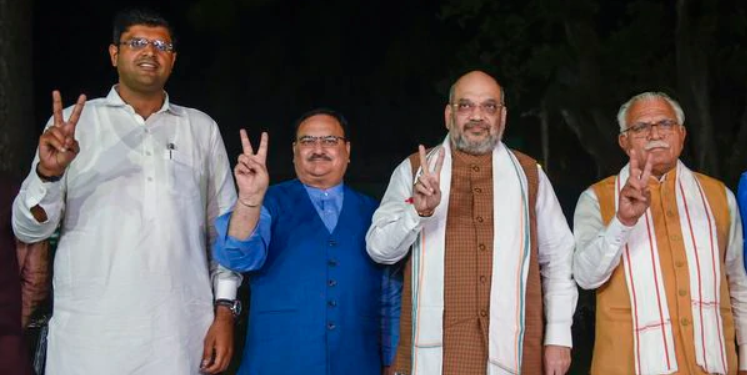The 2019 Haryana elections sprang up many surprises and one of the major surprise was the rise of Jannayak Janata Party (JJP) and its leader Dushyant Chautala. In Haryana, the ruling BJP emerged as the single largest party by winning 40 seats but fell agonizingly short of the magic figure of 46 seats. Congress, on the other hand, won 31 seats whereas JJP emerged victorious in 10 constituencies and since then speculations were rife that JJP, the ‘kingmaker’ might side with Congress to form the government.
However, dismissing all the hearsay, JJP decided to go with Khattar and the BJP. What led to Chautaula going the other way when he could have kept the BJP out of power and also bargained a deal with Congress to become the CM? The answer simply lies in the fact that Chautala played the big game by being smart and took lessons from the past Congress alliances which have eventually turned sour with the other party often ending up in total disarray.
The JDS-Congress coalition fiasco is still vivid in the public’s memory and certainly, Chautala must have also recalled it this week. The alliance between Congress and JDS was formed in desperation to get power and keep the BJP out. But the ‘opportunistic’ alliance could not bury the inter-party rivalry and deep hatred for the leaders and the demons came out no sooner after the alliance was announced.
After HD Kumaraswamy’s oath as the Chief Minister of Karnataka, a bitter fight ensued between Congress and JDS over the distribution of cabinet portfolios in the government. The alliance somehow sailed for a year but it was always a stormy one with accusations flying from one side to another, mostly resulting in a moist-eyed CM.
Kumaraswamy had become fed up of the Congress and in the month of July last year broke down into tears at a public event expressing his anger saying, “All of you are happy because your elder or younger brother has become the chief minister. But I am not happy. I am swallowing my own pain like poison, like Vishakantha (Lord Shiva, who drank poison to save the world).’’
After a 13-month-long tussle, the alliance finally fell apart, and Kumaraswamy looked back at it and said in an interview, “The 14 months that I was in power, Congress treated me like a clerk. How long do you want to be a slave? I have even been humiliated by a Congress legislator, who threw a bunch of papers in my face.” His tenure was truly reminiscent of the coalition era when governance suffered the compulsions of coalition.
Another example would be the JDU-RJD alliance which came to power in Bihar amidst much hoopla. Bihar Chief Minister Nitish Kumar’s shift from being allied to the Rashtriya Janata Dal (RJD) to forming a government with the BJP took place in the space-time of 14 hours.
The unlikely alliance of once bitter rivals, termed as Mahagathbandhan was always going to be a rough ride, especially after the mandate received in November 2015 by Lalu Prasad Yadav led RJD that emerged with the highest mandate. Lalu suddenly getting so much political power after being sidelined by the BJP-JDU alliance sowed the seeds of the break up which ultimately led to the endgame where the two political parties split up in July 2017.
The internal contradictions of Nitish Kumar and Lalu Prasad’s politics plagued the Mahagathbandhan during its brief run. Yadav was hell-bent on projecting his son, Tejaswi Yadav as the next generation leader, while Nitish Kumar felt hampered by the heavy presence of Lalu Prasad in administrative issues. And when Prime Minister Narendra Modi visited Patna for the Prakash Utsav, the 350th birth anniversary of Guru Gobind Singh and shared the stage with Nitish Kumar, the old flames were rekindled and Nitish came back to the ever-reliable fold of NDA.
The above two case-studies prove that Congress, or for that matter, other regional political parties are often motivated by personal vendettas and only form alliances to keep the BJP out, especially after 2014 and the Modi juggernaut that has kept on rolling since then.
The scion Chautala, a fourth-generation dynast, is the great-grandson of former deputy Prime Minister Devi Lal and grandson of jailed INLD leader O.P. Chautala and he certainly used his political lineage and wisdom to make the best of the situation.
As we have seen from the Karnataka experiment where Kumaraswamy was reduced to a puppet and left to fend for himself in the middle where Congress tried to muscle its way in every decision Kumaraswamy tried to take. Going with Congress in Haryana would have meant that JJP and Chautala would have got the coveted Chief Minister’s throne but in hindsight it would have been a short-term gain only.
The fact that BJP as a party always values its alliance partners more than anything else, as seen in Bihar and Maharahstra, also contributed to JJP siding with the BJP. The underlying theme of the decision took its shape because of the Bangalore and Patna connection which has proven that if you want to retain power and work five years continuously for public welfare without any major hiccup, it is only BJP that stands the test of times and allying with them is a decision that one with a sane-mind should take.
It also cements the fact that BJP, when it emerges as a party with a considerable seat mandate in any state does not let go of the opportunity to form the government and it is something that the BJP president Amit Shah has truly excelled in.


































